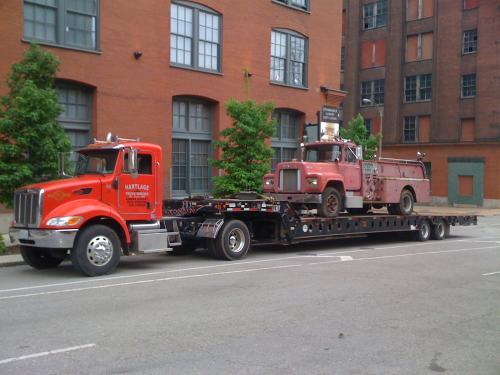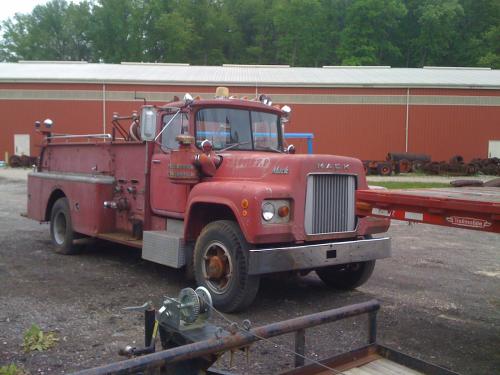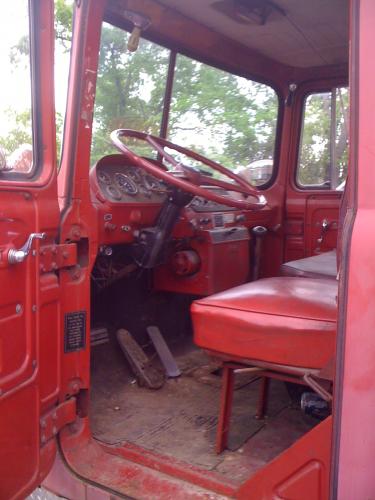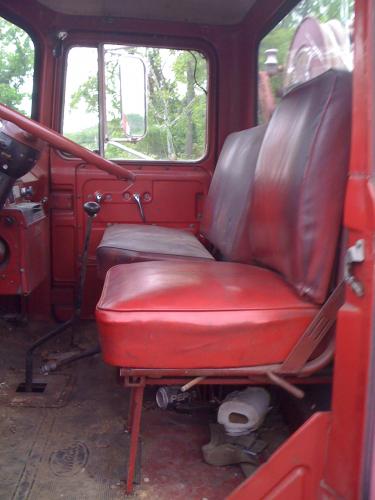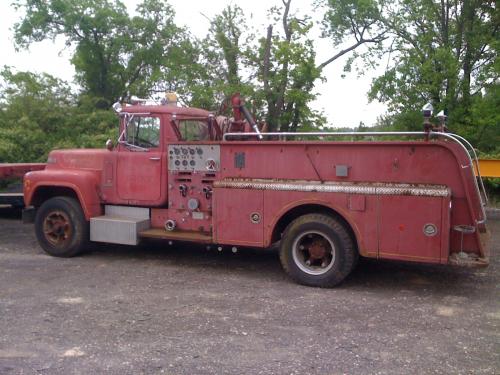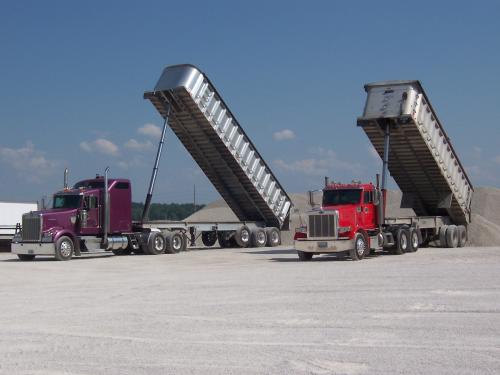-
Posts
276 -
Joined
-
Last visited
-
Days Won
2
Content Type
Profiles
Forums
Gallery
Events
Blogs
BMT Wiki
Collections
Store
Everything posted by convoyduel
-
No, the b/w photo is a end-of-production RS/RL7. The center rib long hood is extremely rare. They were fairly common on the RL/RS6 Value Liner series. I was told by a retired Mack engineer that the rib was for strength and stiffening as much as anything. The RL/RS7 hoods had a moderate stress cracking problem, especially when repeatedly lifted by the rear of the fender. End of production numbers would be VIN #'s 35500+ or so, give or take. 35500 would have been spring of '77. RW Superliners started not long after. The yellow RS7 is early production, pre'73 when the RS/RL7's shared hoods with the eastern R7's. Western cabs/hoods are mounted higher on the frame than the eastern models. In order to address the disproportion, the western models received new hood designs starting in late '72. The new hoods had the dropped fenders, longer side sill on the hood and the chopped fender splash guard arrangement. Battery box arrangments switched from the yellow photo to the b/w photo style in '74 mid production.
-
We picked up the R608F today. I was shocked at how well it ran. Having never dealt with a 707, what is the reason behind Left, Right and Dual Ignition. Truck runs and idles beautifully on dual. I'm not sure I understand why you would want to only run on one side's plugs or another.
-
You couldn't get one back into that kind of shape for $22,500. I understand your apprehension with the price, but a Superliner in that kind of shape with those options will easily go for $22,500 before long. You might get them to wiggle down to $21,000 or negotiate a set of drives into the price, but I think you'd do well to get either. If the motor has good paperwork, the price is not likely to waver much for the rest of the truck in that kind of condition.
-
I thought my books showed only 5 of the sedans, but either way, the only thing more rare was Port Vue's open cab R611F. I remember seeing those pics as well. I was thinking they found it under an overpass or something, but I do remember it was little more than a shell. I wound up buying the R608F this week. We're picking it up Wednesday or Thursday and hauling it to the Museum of Transportation for the time being. There's a truck show and fire muster there this Sunday, so it should provide for some good conversation. Since my first post, I found the disposition of all 12 of the St. Louis R608F's. Most of them wound up going through Harry Harless in Birmingham and ending up in small departments around Dothan.
-
What year was your R608F? If it is the one they have pictured on their website, it must be among the last of the 61 produced.
-
Group, I have come across a Mack R608F pumper, SN 1006. It was an old St. Louis City pumper and is still here locally. It's been outside for at least the past 10 years, maybe longer. After the FD, it wound up with the City Parks Department as a flush truck. The interior is in very good condition, but the exterior needs a full restoration. No structural corrosion on the cab, some cracks in the hood and some rot taking hold in the body cabinets. All of the other goodies are there. Chrome items are starting to rust pretty good, although the bed top rails are still in great shape. Tires are rotten. Everything looks pretty decent under the hood. Wiring is okay, even still has the little light on the firewall by the steering shaft. Does anyone have any info on these? My Mack Fire Trucks book shows only 61 of the 608's made. Judging from the SN and the relative quantity of them in St. Louis, I assume St. Louis was the first department order. I'm going by FD HQ tomorrow to meet a guy who knows a bit about these specific units and where they were stationed. I remember these as reserve units here when I was growing up. I never realized they were 608's with the 707, I always assumed they were diesels. I'm looking for just about anything on these, even any issues with the 707. The owner wants 3 for it, I was thinking it is a bit high, given its condition. Now if it was an FDNY R model sedan cab, that's a different story.
-
I ordered my 2002 RD heavy spec tri-axle dump with one special. Loved that 355/380. Great torque, great power, great fuel mileage. It saved about $2200 over a 427 e7 at the time and around $4000 over a 460. Only down side was the special order put the truck behind 6-8 weeks for an "engineering review". No big deal. Caused the RD to come out as an RD690 instead of an RD688. Dealer changed the setting to always give 380.
-
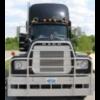
Truck I'm Looking At
convoyduel replied to cgallamore's topic in Modern Mack Truck General Discussion
That silver truck in bigen's avatar is definitely a CHN Rawhide edition. I'm not sure what the post means either. -

Not Picking It Up On Monday
convoyduel replied to cgallamore's topic in Modern Mack Truck General Discussion
Is anyone else at a total loss here (obviously besides bigen)??? The pictures on that Truck Paper link show a truck in very good condition. Were those pictures current? I'd raise holy hell if I drove that far on a sham. Bigen, sorry to hear about your troubles. I hope you at least took a load up that way. -

Truck I'm Looking At
convoyduel replied to cgallamore's topic in Modern Mack Truck General Discussion
Sounds like they're giving you about $23K to $25K for your CX. I don't know what you paid, but are you really willing to take that for your truck? You might be better trying to see what you can get for yours outright. By the way, Baxmeyer Construction over in Waterloo, IL has a fleet of 5 to 10 CX's, most of which are MP's, but maybe some ASET's. I drove by their yard today and saw the CX's but also a whole fleet of new Peterbilts. They have run Macks for years. May not hurt to call them up and ask for their experience. -

Truck I'm Looking At
convoyduel replied to cgallamore's topic in Modern Mack Truck General Discussion
bigen, I think you're looking at stepping into a real big pile potentially. You're wanting to get rid of your CX because of all of the repairs and you're looking at getting basically the same truck. It would seem to me that the biggest risk of owning one (ASET Mack) with a single truck fleet is that your always covering the repair costs out of a single source of revenue. These trucks obviously have a history of frequent repairs and upgrades. You're looking at getting into one of these at the end of the warranty, while it appears that the owners are getting out of them right as they would have to foot the bills on their own. Going with a new or recent Mack with an MP might be better in some respects like fuel, but then you're so buried in one for what you've paid that you can't get out of it without taking a total bath. Waiting several years is the likely option and that seems like what the owners did with these trucks you're looking at. I hate to say it, but running a Pedigreed truck west is a bit different than running Brand X. Trucks that are All Mack have no warranty unless you're at a Mack dealer (don't know about finding a Swedish Sweatshop, they may honor Mack warranty since they own them). Non-warranty work on the road can be done anywhere, but if it involves things that are only found in Macks, you're better off to not let anyone else touch it. I would look very hard for a pre-ASET Mack with decent miles and an excellent service history. Not only will you get into if for less, you're not dealing with a truck that is legendary for problems. If you do stay with Mack, I'd look very hard at trying to find one locally so that you can work with the dealer if you have problems after the fact. -
One of our '04 CH613's had it, the other didn't. I prefered the one without it. All the computer in the dash did was give you a bunch of high end functions, various temperatures, digital readouts of things you already had gauges for, etc. It let you be able to change selections on certain programmable items, but nothing big that I can remember. One "advantage" is that it would tell you what code was showing when lightning struck. Other than that, I just looked at it as something very expensive to go wrong. Don't recall anything about system failures if the computer display went bad.
-

Truck I'm Looking At
convoyduel replied to cgallamore's topic in Modern Mack Truck General Discussion
3.90's on 22.5 tires with a 13 speed sounds a bit too slow of a gear for west cost/48 state operations. If you run 70mph, that would put you around 17-18RPM. I would think for an over the road truck, you'd want something at least in the 3.70 range. What gears do you have now? If I remember correctly, one of the issues with the Mack approach to 10/02 emissions and up was that it was fairly important to put the engine between 1550 and 1650 at your expected cruising speed. Not only did that maximize fuel economy, it is also the design operating RPM of the engine with respect to cooling and/or heat transfer for highway speed operations. -
Bigen, That black '08 was a Holthaus truck. They used to run CL613's with sleepers, then switched to the CHN/CHU's. I looked at that truck as well (just for fun). I happened to catch a Holthaus driver at F&C last week and asked him about their new trucks. Didn't sound like they had the best of luck with them. I sort of suspected that the truck came back with problems, but I don't know that for sure. Good luck with your search.
-
The leasing plans from the major outlets such as Penske and Ryder are targeted to companies that have trucks which are incidental to their primary business. In other words, they make a product or provide a service that requires them to provide transportation as a package deal. The very high cost of these leases are rolled into the price of their service or product. Leasing the trucks (and typically a full service lease at that) allows the company to focus on its core business but also allows them to not have to worry about a revolving door of carriers or one-time-thru owner operators that have a learning curve on each haul. In the case of smaller fleets, the cost of having a safety manager and maintaining DOT paperwork in-house often exceeds the cost of just farming out the DOT work as part of a comprehensive lease. Maintaining a few driver logs is easier than IFTA, IRP, DOT inspections and the rest of the regs dealing specifically with vehicles. For trucking companies, especially small operations, there isn't anywhere near enough profit in a load or the market to offset the increased cost of a lease, especially a full-service lease. A new truck might cost around $1500 per month. A lease, will cost around $1800 or more plus another mileage charge that totals $400+ per month. Add to that, routine wearables like tires and brakes and you're looking at a huge chunk of change. The local Mack dealer in St. Louis (F&C) has an in-house rental and leasing service. Their rates are extremely fair, but even as thinned down as they are, the dollars still work out in favor of ownership on every level. We used them on a short term lease (long term rental really) and it worked pretty well for seasonal work. They also really had the market pegged with their trucks as most of them had single line wet kits already installed. Using their rentals was a great way to keep the customer happy and keep out competition cashing in on an unforeseen maintenance break down. Rental rates often left no profit whatsoever, but it kept a driver paid, keep revenue flowing and others out. There are also leases (usually called TRAC leases) with a super low buyout ($1 or similar) that are developed for tax purposes that payoff like a loan but are leases in name only. In some cases, $1 TRAC leases may not always be 100% deductable, depending on laws and regs. A big "gotcha" in leases for small operations or individuals is that transitioning from a financed vehicle to a lease can often lead to unusually low lease payments on the FIRST lease. The equity in an owned or financed vehicle, when traded in, is applied against the total lease value, making the $ value leased lower than if no trade or down payment were made. At the end of the lease, there is no value in the vehicle to the customer (lessee) and the owner (lessor) takes the vehicle back. The customer wants to lease again, but this time, they probably didn't save any money for a down payment and they have no value in the lease vehicle they just turned in, so their cost basis for the new lease vehicle is full value, resulting in much higher payments. Tax laws allow the entire incurred cost of the lease to be expensed as it is payed out. In other words, if in a calendar year, you spend $18,000 on lease payments and an additional $6000 on mileage expenses on the lease and bought a $3000 set of tires, your books will show a $27,000 expense against income (revenue). For that same truck purchased using conventional financing, assume you paid out $18,000 in loan payments. You also bought the same $3000 set of tires. At the end of the year, you can show $3000 worth of expense for tires, dollar for dollar expenses of any parts or service paid for on the truck that year and that's it. The cost of your truck is expensed through depreciation. Where it really gets complicated is that the depreciation can be linear (same amount each year) or accelerated (more up front then the balance in equal sums). If your operation already has a net loss before depreciation (you spent more than you earned), you often cannot take any depreciation. There are rules that prevent a company from using depreciation to "further a loss". In that case, you may never be able to depreciate the truck. This is especially critical if you are using an LLC or Subchapter S corporation to pass profit or losses over to your personal tax return. You would need to talk to a CPA or tax attorney to find out how each case could specifically impact your operation.
-
Glad to hear Rick and the bunch at F&C took care of it. In my experience, their service and parts departments are A+. Did you buy the Vision there? I think I saw your old CL on their lot not long ago.
-
We never had any overheating problems grossing 110k to 120k around St. Louis with our '04 CH613 AC427's. That being said, I do know that higher operating temps on the AC427's did affect the longevity of other components, including belts, hoses and bearings. I would, without a doubt, keep a spare belt in the truck at all times. I know early on, the tensioner idler pulley had a very high failure rate due to grease boiling out of the bearing. That may have been fixed with later revisions or updates.
-
1. You're a rare person who shows a remote interest in an out-of-warranty ASET Mack, despite their industry-wide bad reputation. 2. This is the absolute worst truck sales economy in modern history. 3. You have a truck that is much more marketable (price, quality) for them that they would love to steal from you if you'd trade OF COURSE THEY ARE PRACTICALLY BEGGING YOU!!!!! Be completely honest with yourself. If the ASET still isn't enough of a factor, The Jake alone on this deal should be enough to walk away. At $6K, you're already talking in-frame price or darn close to it, and that is what you said was your worst fear on your current CH that you know most everything else about. If it were me, I'd have to consider the fact that its not the truck for me if it needs an option installed that costs 15-20% of the purchase price (assuming price in the $30's for it). Whatever you decide, I hope you make the right choice for you.
-

Jack Of All Trades....
convoyduel replied to RowdyRebel's topic in Modern Mack Truck General Discussion
Some good points, but you're not factoring in loading 40K to 50K onto a single axle when dumping. Also, with a frameless, either the tractor is moving rearward as the trailer raises, or the trailer is moving forward. Either situation puts the "base" in motion and that's where stability gets compromised. With a frameless, your brakes are set, bags are dumped. When the load's at the bottom, maybe pull forward a few feet to clear the gate. As I said, though, it depends on what you're shooting for. If I had nothing but freeway/longhaul work, I wouldn't do anything but frameless either to maximize the payload. -

Jack Of All Trades....
convoyduel replied to RowdyRebel's topic in Modern Mack Truck General Discussion
Backing up a bit to end dump specs, the type of trailer you want is very specific to what you're hauling and where. The 39's, frameless and 1/4 frames are designed to scale out exactly 80K for long-haul interstate work. You can't use them much above 80K for long and their very unforgiving in use on uneven ground. They mostly are for use on dumping in bins, chutes, and established offloading sites or well maintained stockpiling. Frameless (and 1/4 frame) are great when you don't care about the trailer laying over. If you want to keep it stable, use a frame type, but if it goes, it takes the tractor with it. In my experience, I'd rather have a more stable combo and take an extra few minutes to let the load slide out easy rather than hot dog it and try moving with a raised trailer. Even with wet lead in the winter, patience and a liner will keep you on all tires. I can't count the number of times I'd see a tub jockey tearing forward with end dump in the air like they were driving an old Louisville with a 10 foot scissor lift Galion in the air. The frame-type trailers are the brutes that really can haul the tonnage, take the rough terrain and stay stable in the air. I ran 28 to 35 foot frame type trailers, all alum body with steel frames, except one alum/alum. The tare was a bit higher, but we hauled primarily in the commercial zones in St. Louis, typically moving 35 to 40 tons of material or more in single turn. When we had to run long, we were down to 24.5 tons avg. payload, but even the super lights running 39' frameless were only getting a few tons more (usually b/c the frameless were pulled by sleeper tractors). Never had a single problem, none of my all-starts turned any over, but we sure ran around a lot of toppled Beelman and Grantham trailers laying on their sides. The biggest competition for us was the truck-and-pup combos, with big heavy tri-axle dump trucks pulling tandem or tri-axle pups. Those tri-axle dumps weigh 28K to 30K empty and the rock tub they're pulling is another 12 to 15K. I never understood how they made any money. In the offseason, we could drop our end dumps and pull other trailers, they couldn't shed their beds too well. After I started running 35's and tractors, Lloyd Lynn, Pazdera and others started switching over. Can't say I was the reason, but I was certainly well ahead of the curve. As for Midwest bigen, a couple of my first hauling jobs were for Midwest at Antonia working on-call with Randy with my first truck in '01 when he was still there. I moved on and up right away and never had any real problems there, the problems came later on with some of the local snakes in the grass that bit me, but in the end, it all evened out. I'm sure you and I've crossed paths more than once as the St. Louis market is pretty small in the end. God knows I've got quite a few stories from my 6 years spent in the industry before I sold everything off. -
The lack of an engine brake caught a lot of people and even dealers off-guard when the ASET's came out. Most everyone was used to being able to throw a jake on later for around $1500, be they Mack, Cat or Cummins. In fact, in many cases, dealers realized it was cheaper to order the engines without the jake and put them on later rather than order one up from the factory. That all changed with Mack's ASET's as the top side of the engine was plumbed different with a jake versus without. In addition to the jake assembly, there were a lot of other parts that had to be changed and a jake upfit was pushing $5K if I remember correctly. One of my 2 got upfitted with the jake. They were both "stock" models for the dealer when they used to order around 30 or so identical per year to have on hand. If I remember correctly, my jake was their learning curve for the ASET.
-
Most have just about nailed it. The AI's were internal exhaust gas recirculation putting the NOx back into the cool air heading to the combustion chamber. From the outside, they didn't look all that much different from the last of the E7's. They were used in MR's, RD's, DM's and Granites. The AC is the external cooled exhaust gas with all of the junk that hung off of the turbo side of the engine. The EGR coolers were intended to cool exhaust gas with engine coolant, thus the significantly higher underhood temps. I had 2 '04 CH613 SFA's with the 427 ASET AI's. They rode well, pulled very very well and got decent fuel economy, but like clockwork, every 25000 miles they threw turbos. Also, they boiled out coolant, boiled out grease from pulleys and burnt hoses and belts right off of the truck. The head was unbelievable in those and when they broke, they were down for a long long time as parts were so very scarce. There were dozens of updates to those, so many so that often there were updates that had to be made on the dealer lot for new trucks that just convoyed from the factory. In addition to these problems, there were multiple major problems with block casting failures, where sand or other debris was getting left in the blocks through assembly. A friend of mine spent 4 years running around the country from '04 to '08 working for Mack just tearing down brand new engines and rebuilding them from the defect. Most customers never knew their brand new truck had an engine with 10 hours that had already been torn completely down and reassembled in a shop. The problem with the ASET-AI's is that they are now all finally coming out of warranty, so the recurring failures are finally off of Mack's books. That also means that they are not going to be as driven to find solutions for new problems that crop up on these smoking turds on someone else's dime. After just under a year, I drove both of my '04's back to the dealer on a Friday afternoon and left them on the lot in front of their door. We had a long discussion and they took care of me. I never drove those trucks again and wound up buying two used Peterbilts for a fraction of the cost. I still see one of the two trucks almost every week at a local paving company. They continue to have a lot of problems with it, and it mostly sits anyway. By the way, the two Lindahl Pete's I bought had 365 Cat 3176's with just under 300k on them. I ran them for 3 years and never spent a dime on the powertrain, and they never missed a single day's worth of work. I wound up selling them for what I paid. I was at a Ritchie Brothers auction last week here in St. Louis and watched two nice '01 Visions with 550K on them, 355/380's, 64" hi rises go for $5000 apiece. They were very decent trucks in great shape overall. If I'm going to take a gamble and trade a known for an unknown, I'm going to make sure I don't have the farm bet on the new truck being in worse shape than the old one. I wish you luck in your decision.
-

Old Beelman R Model
convoyduel replied to Double L's topic in Antique and Classic Mack Trucks General Discussion
That's one of the few pictures I've seen of a Beelman truck still upright on its wheels. -
I walked down the entire line with my new '02 RD in late April 2001. It was absolutely a fantastic experience.
-

Titan Finally Arrived
convoyduel replied to granitefan713's topic in Modern Mack Truck General Discussion
The price on the Titans vary with options, especially with the engine. Locally, a Titan with the 605hp engine runs above $150k. You're also working in 20/44 axles, heavy frames, heavy driveline components etc., so its not easily compared to a road tractor price. That being said, Mack is running around $35K higher on a Titan versus a comparable heavy spec Paccar, International or Daimler product. These are not trucks that any dealer would stock based on price and this market. In the St. Louis region, there were typically 15 to 20 severe duty trucks sold per year, mostly in the dump truck market. Since the 4th Qtr of '07, according to an industry source, I believe that the cumulative total sold is less than 5, including all makes and dealers.
BigMackTrucks.com
BigMackTrucks.com is a support forum for antique, classic and modern Mack Trucks! The forum is owned and maintained by Watt's Truck Center, Inc. an independent, full service Mack dealer. The forums are not affiliated with Mack Trucks, Inc.
Our Vendors and Advertisers
Thank you for your support!



